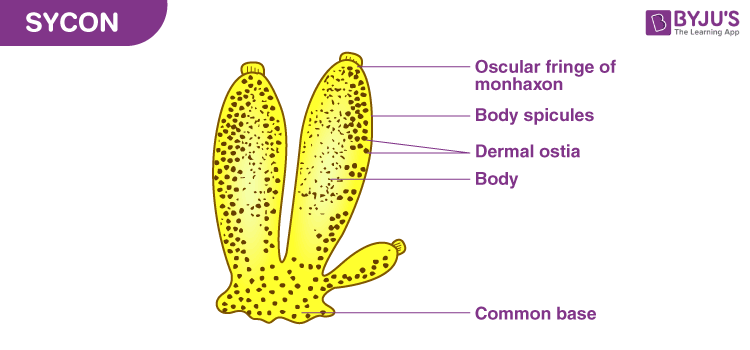Sponge
The members of the phylum Porifera are commonly called sponges. They are asymmetrical marine animals. Though they are multicellular animals, they have a very primitive body organisation. For example, they have a canal system for water transportation. Moreover, they are hermaphrodites (sexes are not separate).
Structure of a sponge
It has minute pores called Ostia through which the water enters. The water reaches the central cavity or spongocoel, and later leaves through an aperture called the osculum. This water pathway transports food, helps in the exchange of gases and removal of waste. Their whole body is supported by skeleton-like structures called spicules. Also, the central spongocoel is lined by collar cells called choanocytes.
Extended Reading: Phylum Porifera

Hydra
Hydra are freshwater, radially symmetrical animals under the phylum Cnidaria. They are diploblastic animals and show tissue level of body organisation. Hydra exhibits a body form called a polyp. It is a cylindrical and sessile form.
Structure of Hydra
They have a single mouth opening called a hypostome. The mouth is surrounded by tentacles (cnida) which have cnidocytes. These cnidocytes contain stinging capsules or nematocyst. They help in defence, the capture of prey and in anchorage. Excretion and respiration occur throughout the body surface.
Also Read: Budding in Hydra

Difference between Sponge and Hydra
|
|
|
|
|
|
Sponges are multicellular organisms belonging to the phylum Porifera. |
Hydra are multicellular organisms belonging to the phylum Cnidaria (Coelenterata). |
|
|
|
|
They are asymmetrical. |
They are radially symmetrical. |
|
|
|
|
They have a cellular-level organisation. |
They are diploblastic and have tissue-level organisation. |
|
|
|
|
Sponges do not have mouths. They have minute pores (Ostia) and an aperture (osculum) to circulate water. |
Hydra has a mouth opening called hypostome, surrounded by tentacles. |
|
|
|
|
Most sponges are marine and a few freshwater organisms. |
Hydra are freshwater organisms. |
Frequently Asked Questions
What are polyp and medusa?
Also see: Difference between Polyp and Medusa.
What is intracellular digestion?
When the food breaks down within the cell’s cytoplasm, it is termed intracellular digestion. Both sponges and hydra show intracellular digestion. Here, the food is engulfed by endocytosis and then food vacuoles are formed. This digestion usually happens in the gastrodermis cells.
How does Hydra capture its prey?
Hydra paralyses and kills its prey by using its stinging capsules or nematocysts. These nematocysts are present around the tentacles, and help in defence as well as capturing prey. The nematocyst captures the prey and brings it near the hypostome. Now, the food or prey is slowly moved inside the mouth by the contacting tentacles.
What are organisms under the phylum Porifera?
The phylum Porifera includes the lowest level of multicellular animals. This includes around 5000 species of organisms. Examples – Sycon, Hylonema, Cliona, Euplectella and Spongilla.
Keep exploring BYJU’S Biology for more exciting topics.
Comments